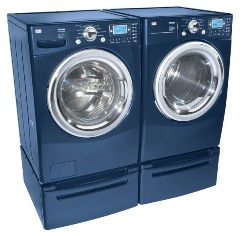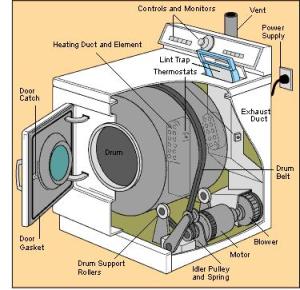A clothes dryer or tumble dryer is a household appliance that is used to remove moisture from a load of clothing and other textiles. We use dryer in our everyday lives along with a washer and don’t pay much attention to them until something breaks down or start to multifunction.
Here are tips on some problems which can occur with dryers. You may still need to hire an appliance repair company, but if the problem is minor you can probably fix it by yourself.
Depending on the age of the appliance and complexity of the problem you may also consider replacing your dryer with a new unit. According to a study by the National Association of Home Builders, the life expectancy of a dryer is 13 years.
How your dryer works.
How does a dryer work? The drum part of the dryer tumbles the clothing so that at any given time some articles of clothing are suspended in mid-air for a moment as they fall from top to bottom in the drum. Then hot air is injected via a gas burner or heating coils. The hot air is passed through the material as it falls, releasing moisture in the form of vapor or stem. The blower then sucks the moisture-laden air out of the drum, and pushes it into the exhaust vent to the outside of the house.
Most common dryer problems:
Slow drying
If the flow of air is interrupted or stopped, the clothes will not dry, because the moisture is trapped inside the drum. If you complaint is slow drying of your clothes then you should check the vent first.
If you have the accordion or flexible type vent, then check it for kinks or other obstructions. It it is too long, with too many curves or los places where ling and moisture can gather, the best thing you can do is remove it, clean it and cut it to the proper length. If you have the rigid type also check it for proper airflow. Clean it if necessary. To check for proper airflow go to the outside of the house and find the exhaust hood. Feel the air coming out of it. It should be a fairly strong flow of air. If it is weak then refer to the above. REMEMBER, all of the air must pass through the lint screen, so be sure to clean it, AFTER EVERY LOAD. And never pull the ling screen out when the dryer is running. The ling could be sucked down the chute into the blower. If that happens you may need someone to take it apart and clean it. If your lint screen is located inside the door, you should check the chute (the place where the screen fits) for ling accumulations. If the screen is full of fine lint and won’t come off, use a soft brush to clean it. Use water if necessary to aid in cleaning the screen. Remember, the better the air flow, the better the clothes will dry.
Dryer won’t start
First make sure the door is closed tightly, re-check the controls and try again. If it still will not start then check to see if you have power. With a gas dryer you can plug a lamp or other device into the outlet to see if it is working. If you don’t have any power, check the fuse or circuit breaker. On an electric dryer you need two fuses or circuit breakers to make it operate. Replace both fuses and try again. If you have circuit breaker then look for a double breaker switch, turn them to OFF, re-set them and try again.
Usually if you have a no-start condition, you have one or more of the following problems, a bad timer, a bad door switch on the newer dryers, an open thermal fuse. A thermal fuse is what prevents the dryer from overheating. It is telling you that you have a plugged vent or other problem.
In this case you will have to call a professional appliance repair service. Before calling professionals you can also check your service manual for additional hints.
Washer and Dryer combination
If you own a combined unit, that is a washer/dryer all in one, then you have a special problem. The blowers on some combination units are unusually weak. The airflow is not as strong as on a free-standing dryer. They require a very short vent to dry properly. If you live in an apartment or condo, check the length of the vent. If it is too long, the drying time will be extended. Most of the dryers in a condo or apartment are not on an outside wall and the vents are usually longer to reach the outside. Most manufactures of dryers recommend no more than 20 feet in the vent system.
Hint.If you want to check to see if the vent is a fault, remove the vent from the dryer and let the dryer vent into the room while running. It may get a little uncomfortable for a while, but if it gets very hot and humid in the room, you will know the dryer is working and the vent is blocked. If the dryer still doesn’t dry, the vent is probably okay and the dryer is defective and needs service.

